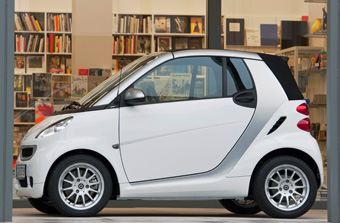
The takeover of Smart’s U.S. distribution network is not a referendum on the American appetite for small cars, according to industry observers.
The A-segment Smart ForTwo, available as a coupe and cabriolet, represents the “extreme small end of the scale,” says Jeff Schuster, executive director-global forecasting at J.D. Power and Associates.
The dynamic between American consumers, volatile gasoline prices and minicars “hasn’t played out yet,” Schuster says, adding Smart’s growth potential is linked to slightly larger cars.
His remarks follow Mercedes-Benz USA’s move to take control of the Smart’s U.S. distribution from Penske Automotive.
Sales of the fuel-efficient 2-seaters never really gained traction despite launching in 2008, when the nation’s gasoline prices reached record-shattering heights.
Smart recorded 24,622 deliveries that year, according to Ward’s data. Since then, sales have plummeted.
Despite continued upward pressure on pump prices and safety ratings that belied the ForTwo’s diminutive presence, Smart tallied 5,927 deliveries in 2010 – a 59.4% plunge from prior-year.
Smart now will move forward with some 50 dealers, specifically those sites that are paired with Mercedes franchises.

The Penske network included more than 20 other stand-alone stores.
Additional product is critical to Smart’s future. “The volume that they’re getting right now is really unsustainable,” Schuster says.
Also, a flood of competitive product is on the horizon.
“Competition in subcompact cars is going to heat up more than a bit and margins are going to be especially thin,” warns Sean McAlinden, chief economist for Michigan-based Center for Automotive Research.
Subcompact cars represent the “most competitive segment in the world,” he adds, noting the current U.S. rollout of the Fiat 500 A-car and the arrival of three Fiat-inspired B-segment Chrysler, Jeep and Dodge vehicles scheduled for 2013.
The Mercedes-Benz takeover eliminates from the pipeline a 5-door B-segment car based on a Nissan platform. But Mercedes-Benz USA spokesman Geoff Day notes Daimler’s joint venture, inked just last year, with Renault-Nissan.
Smart “will be the beneficiary of that small-car strategy,” he tells Ward’s.
Smart’s next-generation models will share a platform with the next-generation Renault Twingo.
Meanwhile, U.S. consumers remain a wild card. “Americans only love small cars temporarily,” McAlinden says.
Small cars accounted for 17.8% of the U.S. light-vehicle market in 2010, according to Ward’s segmentation. That’s down from 2009’s 19.6%.
Sales of lower-small cars, which include the 2-seat ForTwo, fell 1% to 291,306, compared with prior-year.
Despite Smart’s struggles, Penske’s exit arrived as a surprise. “It wasn’t something I was expecting,” Schuster says.
Smart USA President Jill Lajdziak gave no indication of a pending upheaval at last week’s Chicago auto show.
Similarly, Roger Penske, president of the company that bears his name, told Ward’s at the Detroit auto show in January he was “fully committed to the (Smart) brand.”
Lajdziak will remain with Penske Automotive. Mercedes-Benz will appoint a general manager to handle Smart’s U.S. business.




